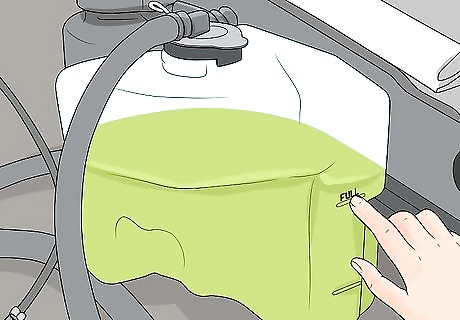
views
Checking the Radiator

Park the car on a level surface. If the car is not level, for instance if it is parked on a hill, you cannot get a true reading of your coolant level. In fact, if you open up your radiator cap while parked on a hill it could cause coolant to pour out.

Make sure the engine is cool. It is very important for your safety that the engine is cool before you open up the cap on the radiator. The radiator is under pressure and displaces a lot of heat, so it can scald you if the engine is not cool before you open it. However, if it's an emergency, such as your car is overheating, you can check your coolant by covering the radiator cap with a thick rag to deflect heat and steam.

Open the radiator cap. The radiator is at the front of the engine and has a cap on the top of it. In order to remove the cap you will need to press down on it and twist at the same time. In many cases, it will take 2 hands to put enough downward and twisting pressure to get it off because there is a vacuum created inside the radiator. To keep coolant off your hands, you can cover the cap with a rag as you take it off or wear a pair of gloves.

Ensure the coolant reaches the top of the radiator. When you take off the cap you should be able to see the coolant right at the top. If the coolant is lower or you can't see it, your coolant level is too low. On some radiators there will be a "full" mark near the top. This is where the coolant level should be.
Looking at the Overflow Tank

Locate the overflow tank. The coolant overflow tank is typically a clear plastic container that is close to the radiator. To identify it for certain you should look for a tube that connects this tank directly to the radiator. The overflow tank should have a cap right on the top that may or may not say "coolant" on it.

Ensure the coolant reaches the "fill" line on the outside of the tank. The overflow tank is made to be relatively clear so that you can see how high the coolant level is inside of it. Look at the sides of the tank to locate the "full" line. This should be marked clearly on the tank. The "full" level will not be at the very top of the tank. This tank is designed to have room to allow coolant to move in and out of it as it gets hot and expands out of the radiator and then cools and gets sucked back into the radiator.

Make sure the tube between the radiator and the overflow tank is secure. In order for the overflow tank to operate correctly it needs to have a secure path to the radiator so that coolant can move between them. Trace the tube and feel along it between the radiator and the tank. Ensure there are no cracks or breaks and that it is secure at both ends.
Making Sure Your Coolant is Effective

Inspect the surface of the coolant for signs of an oil leak. Look for an oily film on the surface on the coolant. Coolant can come in a variety of colors, including red, green, blue, and yellow. However, if the surface is dark or has an oily foam on the surface it may mean that there is a leak in your head gasket. This is a serious problem, so you should take your car to a mechanic right away if you see it.

Test your coolant's general effectiveness with test strips. After it is used for awhile coolant can lose its effectiveness. In order to ensure that yours is still working, you can use test strips. These are available at most auto-parts stores and from online retailers. To get a reading you simply take off the radiator cap and dip the test strip in the coolant in your radiator. Once you dip your test strip in the coolant it will change color. Each test kit will include a scale for how the test strip reacts and what that means for your coolant. If the coolant no longer provides protection, it will need to be drained and replaced.

Use a coolant tester to know the exact protection temperature of your coolant. There are testers available at most auto-parts stores that can be repeatedly used to test your coolant. These are simple tools that are easy to use. You simply take the lid off the overflow tank and stick the hose of the tester in the tank. Then squeeze the bulb on the tester to draw some of the coolant into the tester and read the gauge. The gauge of the tester will move, showing you exactly what temperature the coolant will protect down to.




















Comments
0 comment